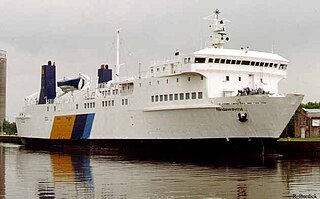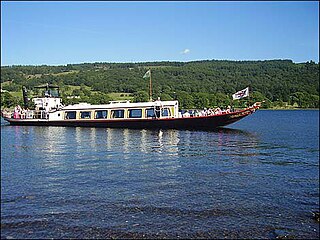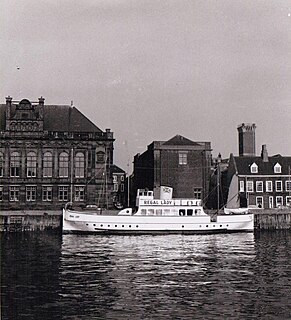
The Mersey Ferry is a ferry service operating on the River Mersey in north west England, between Liverpool to the east and Birkenhead and Wallasey on the Wirral Peninsula to the west. Ferries have been used on this route since at least the 12th century, and continue to be popular for both local people and visitors.

Windermere is the largest natural lake in England. More than 11 miles in length, and almost 1 mile at its widest, it is a ribbon lake formed in a glacial trough after the retreat of ice at the start of the current interglacial period. It has been one of the country's most popular places for holidays and summer homes since the arrival of the Kendal and Windermere Railway's branch line in 1847. Forming part of the border between the historic counties of Lancashire and Westmorland, Windermere is today within the administrative county of Cumbria and the Lake District National Park.

A paddle steamer is a steamship or steamboat powered by a steam engine that drives paddle wheels to propel the craft through the water. In antiquity, paddle wheelers followed the development of poles, oars and sails, where the first uses were wheelers driven by animals or humans.

PS Waverley is the last seagoing passenger-carrying paddle steamer in the world. Built in 1946, she sailed from Craigendoran on the Firth of Clyde to Arrochar on Loch Long until 1973. Bought by the Paddle Steamer Preservation Society (PSPS), she has been restored to her 1947 appearance and now operates passenger excursions around the British coast.

Sealink was a ferry company based in the United Kingdom from 1970 to 1984, operating services to France, Belgium, the Netherlands, Isle of Man, Channel Islands, Isle of Wight and Ireland.

The MV Manx Viking / Nindawayma was a passenger, truck and car ferry, whose last active service was on Lake Huron, operated by the Owen Sound Transportation Company; under contract to the Ontario Ministry of Transportation. In Canadian service she served the Highway 6 route between Tobermory and South Baymouth, Manitoulin Island from 1989 to 1992 alongside the MS Chi-Cheemaun.

MV Royal Daffodil is a former ferry based on the River Mersey, England. From launch until a major refit in 1998 /1999, she was named MV Overchurch, she began service for Birkenhead Corporation Ferries in 1962 and was in regular service on the river until her withdrawal in December 2012. Despite her extensive re-build in 1999, the ship still retains a similar profile to that of her original design. After her withdrawal, the vessel remained idle since her dry docking and survey in January 2013. In April 2019 a new home was confirmed for the ship in the form of a new floating leisure attraction, in Liverpool's Canning Dock.

MS Regal Empress was a cruise ship that recently operated for Imperial Majesty Cruise Line. She was built in 1953 by Alexander Stephen & Sons at Glasgow, Scotland as the ocean liner SS Olympia for the Greek Line. Greek Line withdrew the Olympia from service in 1974. Following an extended lay-up period and reconstruction into a diesel-engined Caribbean cruise ship, the ship re-emerged in 1983 as MS Caribe I for Commodore Cruise Line. In 1993 she was sold to Regal Cruise Line and received her final name. She operated for Imperial Majesty Cruise Line from 2003 until 2009. The Regal Empress was also the last vintage passenger ship to regularly sail from the United States.

The MS Tropicale was a cruise ship that entered service in 1982, and was one of the pioneering cruise ships in the modernization of the cruise industry. The Tropicale was Carnival Cruises Line's first newly built ship, initially operating mainly in the Mexican Rivera and the Caribbean.

The British Rail Class 99 was a fleet of ferries or train ferries, most of which were owned by Sealink, that carried rail vehicles between Britain and mainland Europe. When British Rail implemented the TOPS system for managing their operating stock, these ships were incorporated into the system in order to circumvent some of the restrictions of the application software. This allowed them to be counted as locomotives while carrying railway vehicles in the same way as a normal locomotive would haul a train.

MV Balmoral is a vintage excursion ship owned by MV Balmoral Fund Ltd., a preservation charity. Her principal area of operation is the Bristol Channel, although she also operates day excursions to other parts of the United Kingdom. The Balmoral is included on the National Historic Ships register as part of the National Historic Fleet.

TSMV Shanklin was a passenger ferry that operated between Portsmouth and the Isle of Wight between 1951 and 1980. Renamed Prince Ivanhoe she went on to become a pleasure cruiser in the Bristol Channel but in 1981 sank off the Welsh coast on her first season.

The steam yacht Gondola is a rebuilt Victorian, screw-propelled, steam-powered passenger vessel on Coniston Water, England. Originally launched in 1859, she was built for the steamer service carrying passengers from the Furness Railway and from the Coniston Railway. She was in commercial service until 1936 when she was retired, being converted to a houseboat in 1946. In 1979, by now derelict, she was given a new hull, engine, boiler and most of the superstructure. She is back in service as a passenger boat, still powered by steam and now operated by the National Trust.

Pearl II is a passenger ship that was built in Germany in 1981.
MV Glen Sannox was a Clyde car ferry launched in 1957. Built for the Arran service, she spent her first 14 years there. Thereafter, she had a versatile career on the west coast of Scotland, lasting over 32 years, including providing cruises between 1977 and 1982. In 1989, she was sold for service on the Red Sea. She ran aground south of Jeddah and lay in a sunken condition from 2000.

MV Dartmouth Castle is a passenger ship operating on the River Dart for the Dartmouth Steam Railway and River Boat Company. She is listed on the National Register of Historic Ships

The MV Regal Lady is a 1930 built steel passenger boat moored at the port of Scarborough, North Yorkshire. She is a National Historic Ship, owned and preserved by Scarborough Pleasure Steamers. The ship participated in Operation Dynamo at Dunkirk, was decommissioned in 1946, and in 1954 was moved to Scarborough and renamed from Oulton Belle to its current name.

The MV North Head was a ferry operated by the Port Jackson & Manly Steamship Company and its successors on the Manly service from 1913 until 1985.

Windermere Lake Cruises is a boat company which provides leisure trips on Windermere in the central part of the English Lake District. It is based in Bowness-on-Windermere, Cumbria.

The SS Raven, sometimes also referred to as the SY Raven, is a steam barge ordered by the Furness Railway for use on the lake of Windermere in the English Lake District, where she has spent her entire working life. She is a member of the National Historic Fleet, and is now preserved. She is the second oldest ship on Lloyd’s Register and the oldest with her original machinery.




















